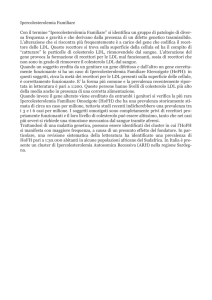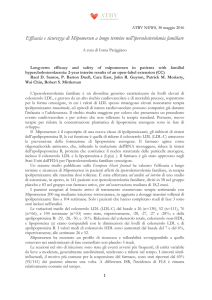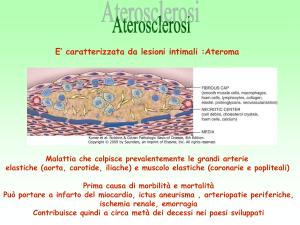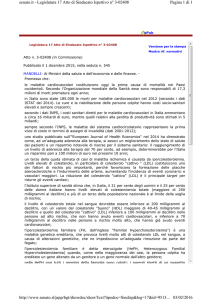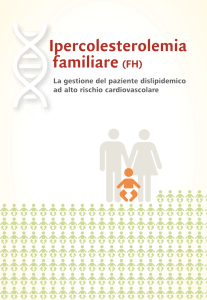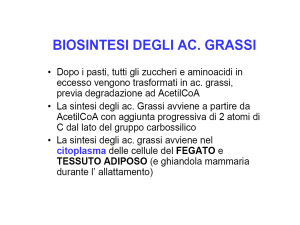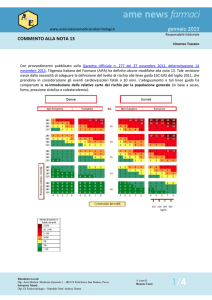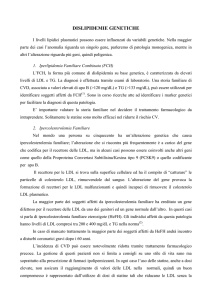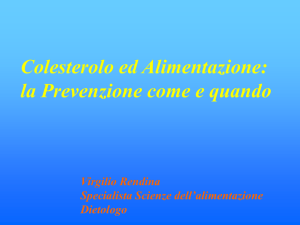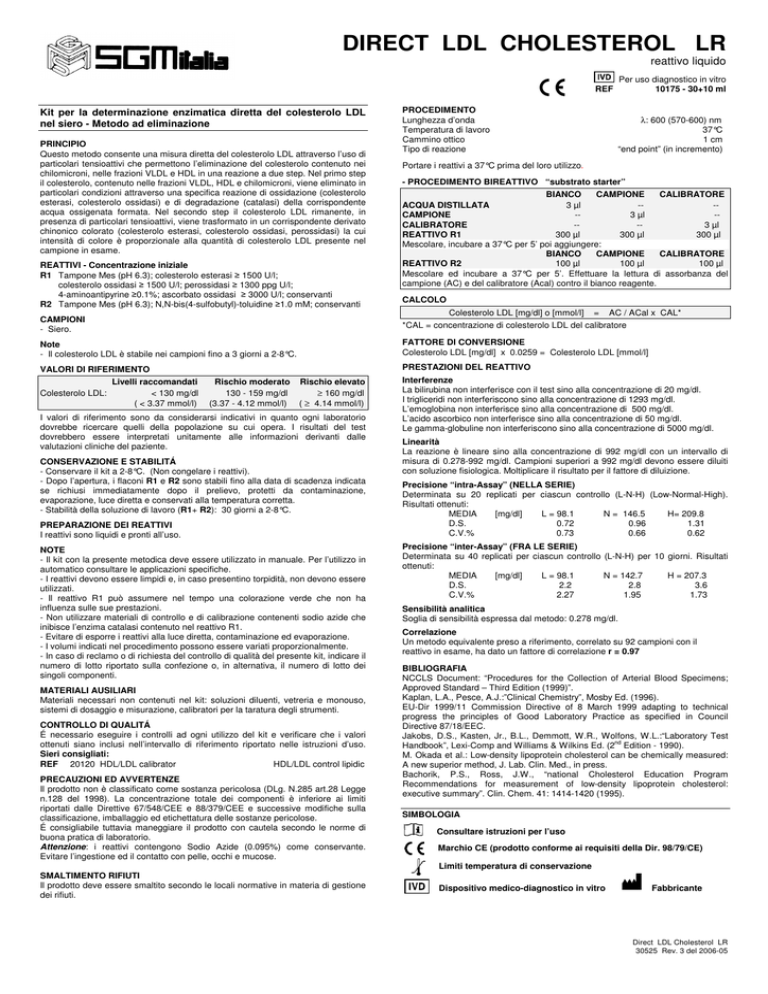
DIRECT LDL CHOLESTEROL LR
reattivo liquido
Per uso diagnostico in vitro
10175 - 30+10 ml
REF
Kit per la determinazione enzimatica diretta del colesterolo LDL
nel siero - Metodo ad eliminazione
PRINCIPIO
Questo metodo consente una misura diretta del colesterolo LDL attraverso l’uso di
particolari tensioattivi che permettono l’eliminazione del colesterolo contenuto nei
chilomicroni, nelle frazioni VLDL e HDL in una reazione a due step. Nel primo step
il colesterolo, contenuto nelle frazioni VLDL, HDL e chilomicroni, viene eliminato in
particolari condizioni attraverso una specifica reazione di ossidazione (colesterolo
esterasi, colesterolo ossidasi) e di degradazione (catalasi) della corrispondente
acqua ossigenata formata. Nel secondo step il colesterolo LDL rimanente, in
presenza di particolari tensioattivi, viene trasformato in un corrispondente derivato
chinonico colorato (colesterolo esterasi, colesterolo ossidasi, perossidasi) la cui
intensità di colore è proporzionale alla quantità di colesterolo LDL presente nel
campione in esame.
REATTIVI - Concentrazione iniziale
R1 Tampone Mes (pH 6.3); colesterolo esterasi ≥ 1500 U/l;
colesterolo ossidasi ≥ 1500 U/l; perossidasi ≥ 1300 ppg U/l;
4-aminoantipyrine ≥0.1%; ascorbato ossidasi ≥ 3000 U/l; conservanti
R2 Tampone Mes (pH 6.3); N,N-bis(4-sulfobutyl)-toluidine ≥1.0 mM; conservanti
PROCEDIMENTO
Lunghezza d’onda
Temperatura di lavoro
Cammino ottico
Tipo di reazione
λ: 600 (570-600) nm
37°C
1 cm
“end point” (in incremento)
Portare i reattivi a 37°C prima del loro utilizzo.
- PROCEDIMENTO BIREATTIVO “substrato starter”
BIANCO
CAMPIONE
CALIBRATORE
ACQUA DISTILLATA
3 µl
--CAMPIONE
-3 µl
-CALIBRATORE
--3 µl
REATTIVO R1
300 µl
300 µl
300 µl
Mescolare, incubare a 37°C per 5’ poi aggiungere:
BIANCO
CAMPIONE
CALIBRATORE
REATTIVO R2
100 µl
100 µl
100 µl
Mescolare ed incubare a 37°C per 5’. Effettuare la lettura di assorbanza del
campione (AC) e del calibratore (Acal) contro il bianco reagente.
CALCOLO
Colesterolo LDL [mg/dl] o [mmol/l]
=
AC / ACal x CAL*
CAMPIONI
- Siero.
*CAL = concentrazione di colesterolo LDL del calibratore
Note
- Il colesterolo LDL è stabile nei campioni fino a 3 giorni a 2-8°C.
FATTORE DI CONVERSIONE
Colesterolo LDL [mg/dl] x 0.0259 = Colesterolo LDL [mmol/l]
PRESTAZIONI DEL REATTIVO
VALORI DI RIFERIMENTO
Livelli raccomandati
Colesterolo LDL:
< 130 mg/dl
( < 3.37 mmol/l)
Rischio moderato
130 - 159 mg/dl
(3.37 - 4.12 mmol/l)
Rischio elevato
≥ 160 mg/dl
( ≥ 4.14 mmol/l)
I valori di riferimento sono da considerarsi indicativi in quanto ogni laboratorio
dovrebbe ricercare quelli della popolazione su cui opera. I risultati del test
dovrebbero essere interpretati unitamente alle informazioni derivanti dalle
valutazioni cliniche del paziente.
CONSERVAZIONE E STABILITÁ
- Conservare il kit a 2-8°C. (Non congelare i reattivi).
- Dopo l’apertura, i flaconi R1 e R2 sono stabili fino alla data di scadenza indicata
se richiusi immediatamente dopo il prelievo, protetti da contaminazione,
evaporazione, luce diretta e conservati alla temperatura corretta.
- Stabilità della soluzione di lavoro (R1+ R2): 30 giorni a 2-8°C.
PREPARAZIONE DEI REATTIVI
I reattivi sono liquidi e pronti all’uso.
NOTE
- Il kit con la presente metodica deve essere utilizzato in manuale. Per l’utilizzo in
automatico consultare le applicazioni specifiche.
- I reattivi devono essere limpidi e, in caso presentino torpidità, non devono essere
utilizzati.
- Il reattivo R1 può assumere nel tempo una colorazione verde che non ha
influenza sulle sue prestazioni.
- Non utilizzare materiali di controllo e di calibrazione contenenti sodio azide che
inibisce l’enzima catalasi contenuto nel reattivo R1.
- Evitare di esporre i reattivi alla luce diretta, contaminazione ed evaporazione.
- I volumi indicati nel procedimento possono essere variati proporzionalmente.
- In caso di reclamo o di richiesta del controllo di qualità del presente kit, indicare il
numero di lotto riportato sulla confezione o, in alternativa, il numero di lotto dei
singoli componenti.
MATERIALI AUSILIARI
Materiali necessari non contenuti nel kit: soluzioni diluenti, vetreria e monouso,
sistemi di dosaggio e misurazione, calibratori per la taratura degli strumenti.
CONTROLLO DI QUALITÁ
É necessario eseguire i controlli ad ogni utilizzo del kit e verificare che i valori
ottenuti siano inclusi nell’intervallo di riferimento riportato nelle istruzioni d’uso.
Sieri consigliati:
REF 20120 HDL/LDL calibrator
HDL/LDL control lipidic
PRECAUZIONI ED AVVERTENZE
Il prodotto non è classificato come sostanza pericolosa (DLg. N.285 art.28 Legge
n.128 del 1998). La concentrazione totale dei componenti è inferiore ai limiti
riportati dalle Direttive 67/548/CEE e 88/379/CEE e successive modifiche sulla
classificazione, imballaggio ed etichettatura delle sostanze pericolose.
É consigliabile tuttavia maneggiare il prodotto con cautela secondo le norme di
buona pratica di laboratorio.
Attenzione: i reattivi contengono Sodio Azide (0.095%) come conservante.
Evitare l’ingestione ed il contatto con pelle, occhi e mucose.
Interferenze
La bilirubina non interferisce con il test sino alla concentrazione di 20 mg/dl.
I trigliceridi non interferiscono sino alla concentrazione di 1293 mg/dl.
L’emoglobina non interferisce sino alla concentrazione di 500 mg/dl.
L’acido ascorbico non interferisce sino alla concentrazione di 50 mg/dl.
Le gamma-globuline non interferiscono sino alla concentrazione di 5000 mg/dl.
Linearità
La reazione è lineare sino alla concentrazione di 992 mg/dl con un intervallo di
misura di 0.278-992 mg/dl. Campioni superiori a 992 mg/dl devono essere diluiti
con soluzione fisiologica. Moltiplicare il risultato per il fattore di diluizione.
Precisione “intra-Assay” (NELLA SERIE)
Determinata su 20 replicati per ciascun controllo (L-N-H) (Low-Normal-High).
Risultati ottenuti:
MEDIA
[mg/dl]
L = 98.1
N = 146.5
H= 209.8
D.S.
0.72
0.96
1.31
C.V.%
0.73
0.66
0.62
Precisione “inter-Assay” (FRA LE SERIE)
Determinata su 40 replicati per ciascun controllo (L-N-H) per 10 giorni. Risultati
ottenuti:
MEDIA
[mg/dl]
L = 98.1
N = 142.7
H = 207.3
D.S.
2.2
2.8
3.6
C.V.%
2.27
1.95
1.73
Sensibilità analitica
Soglia di sensibilità espressa dal metodo: 0.278 mg/dl.
Correlazione
Un metodo equivalente preso a riferimento, correlato su 92 campioni con il
reattivo in esame, ha dato un fattore di correlazione r = 0.97
BIBLIOGRAFIA
NCCLS Document: “Procedures for the Collection of Arterial Blood Specimens;
Approved Standard – Third Edition (1999)”.
Kaplan, L.A., Pesce, A.J.:”Clinical Chemistry”, Mosby Ed. (1996).
EU-Dir 1999/11 Commission Directive of 8 March 1999 adapting to technical
progress the principles of Good Laboratory Practice as specified in Council
Directive 87/18/EEC.
Jakobs, D.S., Kasten, Jr., B.L., Demmott, W.R., Wolfons, W.L.:“Laboratory Test
nd
Handbook”, Lexi-Comp and Williams & Wilkins Ed. (2 Edition - 1990).
M. Okada et al.: Low-density lipoprotein cholesterol can be chemically measured:
A new superior method, J. Lab. Clin. Med., in press.
Bachorik, P.S., Ross, J.W., “national Cholesterol Education Program
Recommendations for measurement of low-density lipoprotein cholesterol:
executive summary”. Clin. Chem. 41: 1414-1420 (1995).
SIMBOLOGIA
Consultare istruzioni per l’uso
Marchio CE (prodotto conforme ai requisiti della Dir. 98/79/CE)
Limiti temperatura di conservazione
SMALTIMENTO RIFIUTI
Il prodotto deve essere smaltito secondo le locali normative in materia di gestione
dei rifiuti.
Dispositivo medico-diagnostico in vitro
Fabbricante
Direct LDL Cholesterol LR
30525 Rev. 3 del 2006-05
DIRECT LDL CHOLESTEROL LR
liquid reagent
REF
Kit for direct enzymatic measurement of LDL cholesterol in serum
Elimination method
PRINCIPLE
This assay can directly measure LDL cholesterol level in serum thanks to an
elimination method that consists of two specific steps. In the first step,
chylomicron, VLDL and HDL are eliminated under specific conditions so
cholesterol is derived only from LDL. In fact these fractions are oxidized
(cholesterol esterase, cholesterol oxidase) to cholestenone and H2O2, that is
subsequently degraded by catalase. In the second step, after various enzymatic
reactions and in the presence of specific surfactants, remaining LDL cholesterol
can be measured specifically as a colour formation (quinone pigment), which
intensity is proportional to the concentration of LDL cholesterol contained in the
sample.
REAGENTS
R1 Mes buffer (pH 6.3); cholesterol esterase ≥ 1500 U/l;
colesterolo oxidase ≥ 1500 U/l; peroxidase ≥ 1300 ppg U/l;
4-aminoantipyrine ≥ 0.1%; ascorbate oxidase ≥ 3000 U/l; preservatives
R2 Mes buffer (pH 6.3); N,N-bis(4-sulfobutyl)-toluidine ≥ 1.0 mM; preservatives
For in vitro medical device
10175 - 30+10 ml
PROCEDURE
Wavelength
Working temperature
Optical path
Reaction
λ: 600 (570-600) nm
37°C
1 cm
“end point” (increasing)
Bring the reagents at 37°C before using them.
- BIREAGENT PROCEDURE “substrate starter”
BLANK
SAMPLE
CALIBRATOR
DISTILLED WATER
3 µl
--SAMPLE
-3 µl
-CALIBRATOR
--3 µl
REAGENT R1
300 µl
300 µl
300 µl
Mix, incubate at 37°C for 5’ and then add:
BLANK
SAMPLE
CALIBRATOR
REAGENT R2
100 µl
100 µl
100 µl
Mix and incubate at 37°C for 5’. Read the absorbance of sample (AC) and
calibrator (Acal) against the reagent blank.
CALCULATION
LDL cholesterol [mg/dl] o [mmol/l]
=
AC / ACal x CAL*
SAMPLE
- Serum.
*CAL = concentration of LDL cholesterol of the calibrator
Note
- The LDL cholesterol is stable in the samples up to 3 days at 2-8°C.
CONVERSION FACTOR
LDL cholesterol [mg/dl] x 0.0259 = LDL cholesterol [mmol/l]
ANALYTICAL PERFORMANCES
REFERENCE VALUES
LDL cholesterol:
Recommended levels
< 130 mg/dl
( < 3.37 mmol/l)
Moderate risk
130 - 159 mg/dl
(3.37 - 4.12 mmol/l)
High risk
≥ 160 mg/dl
( ≥ 4.14 mmol/l)
References values are considered indicatives since each laboratory should
establish references ranges for its own patient’s population. The analytical results
should be evaluated with other information coming from patient’s clinical story.
STORAGE AND STABILITY
- Store the kit at 2-8°C. Do not freeze the reagents.
- After opening, the vials R1 and R2 are stable up to the expiry date if recapped
immediately and protected from contamination, evaporation, direct light, and
stored at the correct temperature.
- Working solution stability (R1+ R2): 30 days at 2-8°C.
PREPARATION OF REAGENTS
Reagents are liquid and ready to use.
NOTE
- The kit, according to this method, must be used in manual procedures. About
automatic using follow specific applications.
- The reagents must be limpid; do not use if turbid.
- A possible green coloration of reagent R1 does not affect the reagent
performances.
- Do not use calibration and control materials that contain sodium azide as it is an
inhibitor for the catalase enzyme contained in reagent R1.
- Avoid direct light, contamination and evaporation.
- The volumes in the procedure can be changed proportionally.
- In case of complaint or quality control request, refer to the lot number on the
package or the lot number on the singles vials.
AUXILIARY EQUIPMENT
Materials not included in the kit: diluent solutions, laboratory glassware,
disposable tips, photometers and calibrators.
QUALITY CONTROLS
It’s necessary, every time the kit is used, to make the quality controls and to check
that values obtained are within the acceptance range provided in the insert.
Suggested serum:
REF 20120 HDL/LDL calibrator
HDL /LDL control lipidic
PRECAUTION IN USE
The product is not classified as dangerous (DLg. N. 285 art. 28 l. n. 128/1998).
The total concentration of components is lower than the limits reported by 67/548
and 88/379 CE Regulations (and following modifications) about classification,
packaging and labelling of dangerous substances.
However the reagent should be handled with caution, according to good laboratory
practice.
Caution: the reagents contain Sodium Azide (0.095%) as preservative. Avoid
swallowing and contacting with skin, eyes and mucous membranes.
WASTE MANAGEMENT
Please refer to the local legal requirements.
Interferences
Bilirubin does not interfere up to concentration of 20 mg/dl.
Triglycerides do not interfere up to concentration of 1293 mg/dl.
Hemoglobin does not interfere up to concentration of 500 mg/dl.
Ascorbate acid does not interfere up to concentration of 50 mg/dl.
Gamma-globulins do not interfere up to concentration of 5000 mg/dl.
Linearity
Reaction is linear up to a concentration of 992 mg/dl with a range of 0.278-992
mg/dl. Samples with values exceeding 992 mg/dl must be diluted with saline
solution. Multiply, then, the result for diluting factor.
“Intra-Assay” precision (within-Run)
Determined on 20 samples for each control (L-N-H) (Low-Normal-High).
Results:
MEAN
[mg/dl]
L = 98.1
N = 146.5
H= 209.8
S.D.
0.72
0.96
1.31
C.V.%
0.73
0.66
0.62
“Inter-Assay” precision (between-Run)
Determined on 40 samples for each control (L-N-H) for 10 days.
Results:
MEAN
[mg/dl]
L = 98.1
N = 142.7
S.D.
2.2
2.8
C.V.%
2.27
1.95
H = 207.3
3.6
1.73
Analytical sensitivity
The test sensitivity in terms of detection limit is 0.278 mg/dl.
Correlation
A study based comparing this method with a similar method on 92 samples has
given a correlating factor r = 0.97
BIBLIOGRAFIA
NCCLS Document: “Procedures for the Collection of Arterial Blood Specimens;
Approved Standard – Third Edition (1999)”.
Kaplan, L.A., Pesce, A.J.:”Clinical Chemistry”, Mosby Ed. (1996).
EU-Dir 1999/11 Commission Directive of 8 March 1999 adapting to technical
progress the principles of Good Laboratory Practice as specified in Council
Directive 87/18/EEC.
Jakobs, D.S., Kasten, Jr., B.L., Demmott, W.R., Wolfons, W.L.:“Laboratory Test
nd
Handbook”, Lexi-Comp and Williams & Wilkins Ed. (2 Edition - 1990).
M. Okada et al.: Low-density lipoprotein cholesterol can be chemically measured:
A new superior method, J. Lab. Clin. Med., in press.
Bachorik, P.S., Ross, J.W., “national Cholesterol Education Program
Recommendations for measurement of low-density lipoprotein cholesterol:
executive summary”. Clin. Chem. 41: 1414-1420 (1995).
SYMBOLS
Read instruction for use
CE mark (requirement of 98/79 regulation)
Storaging temperature limits
In vitro medical device
Producer
Direct LDL Cholesterol LR
30525 Rev. 3 of 2006-05


